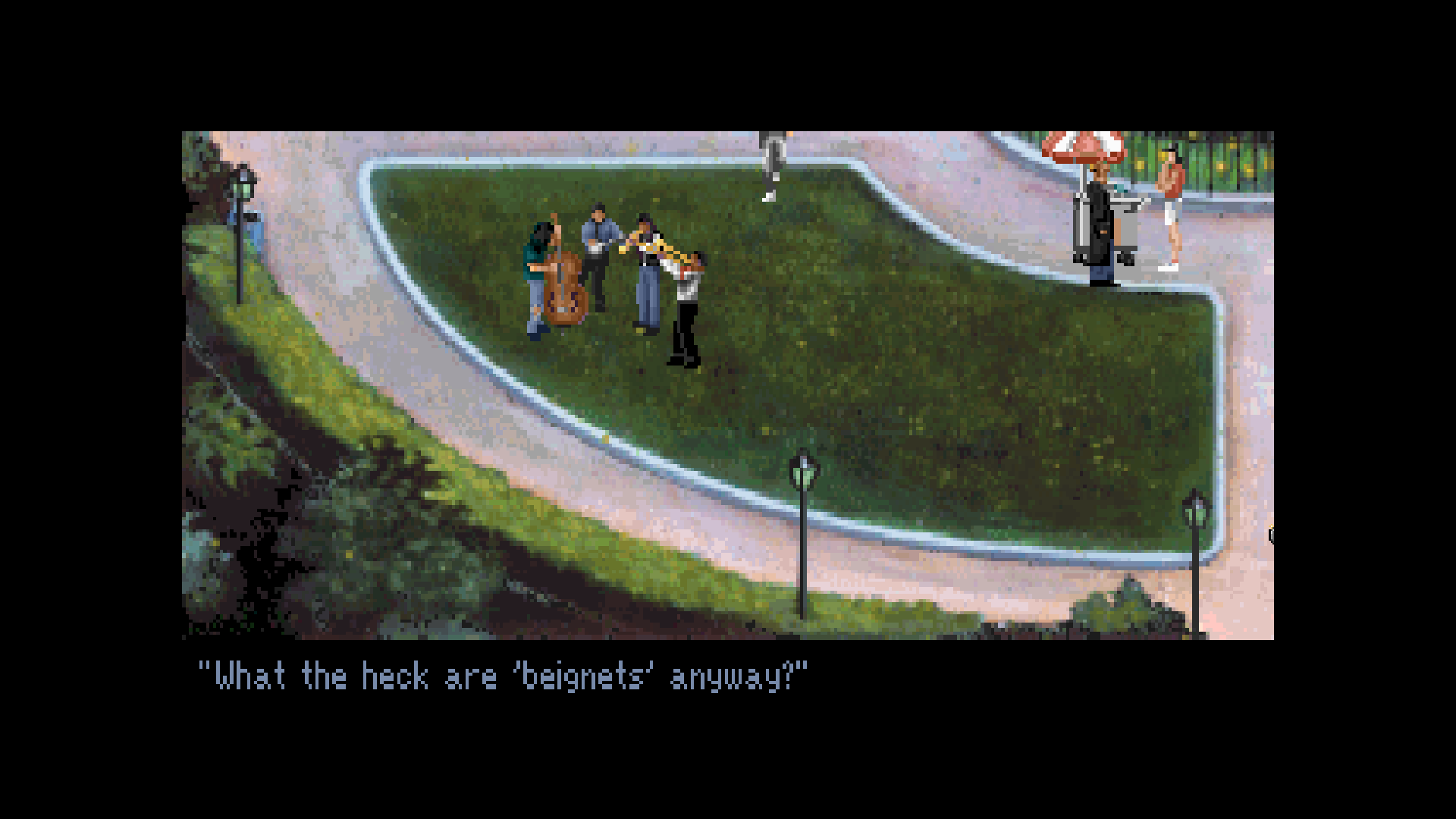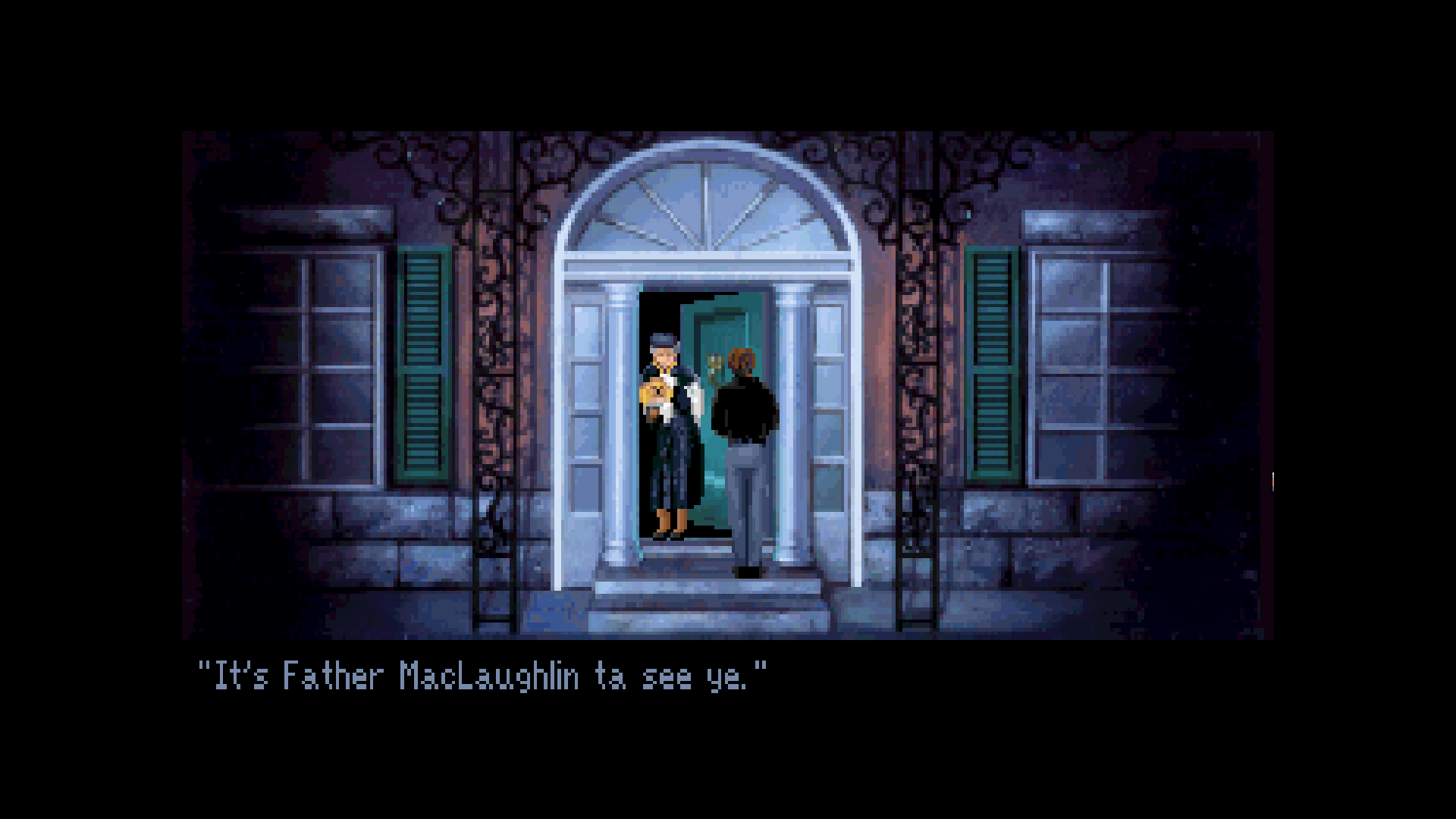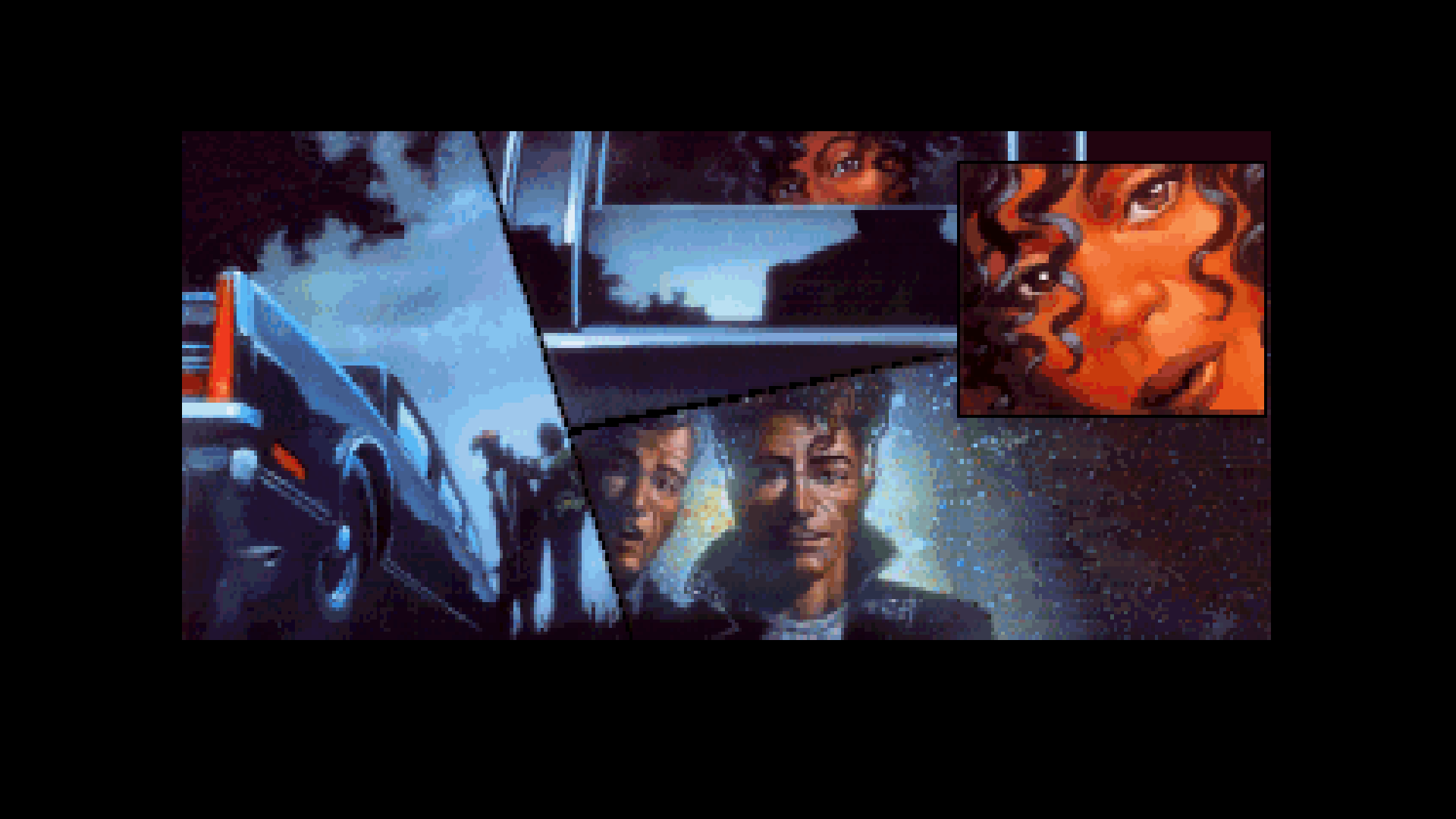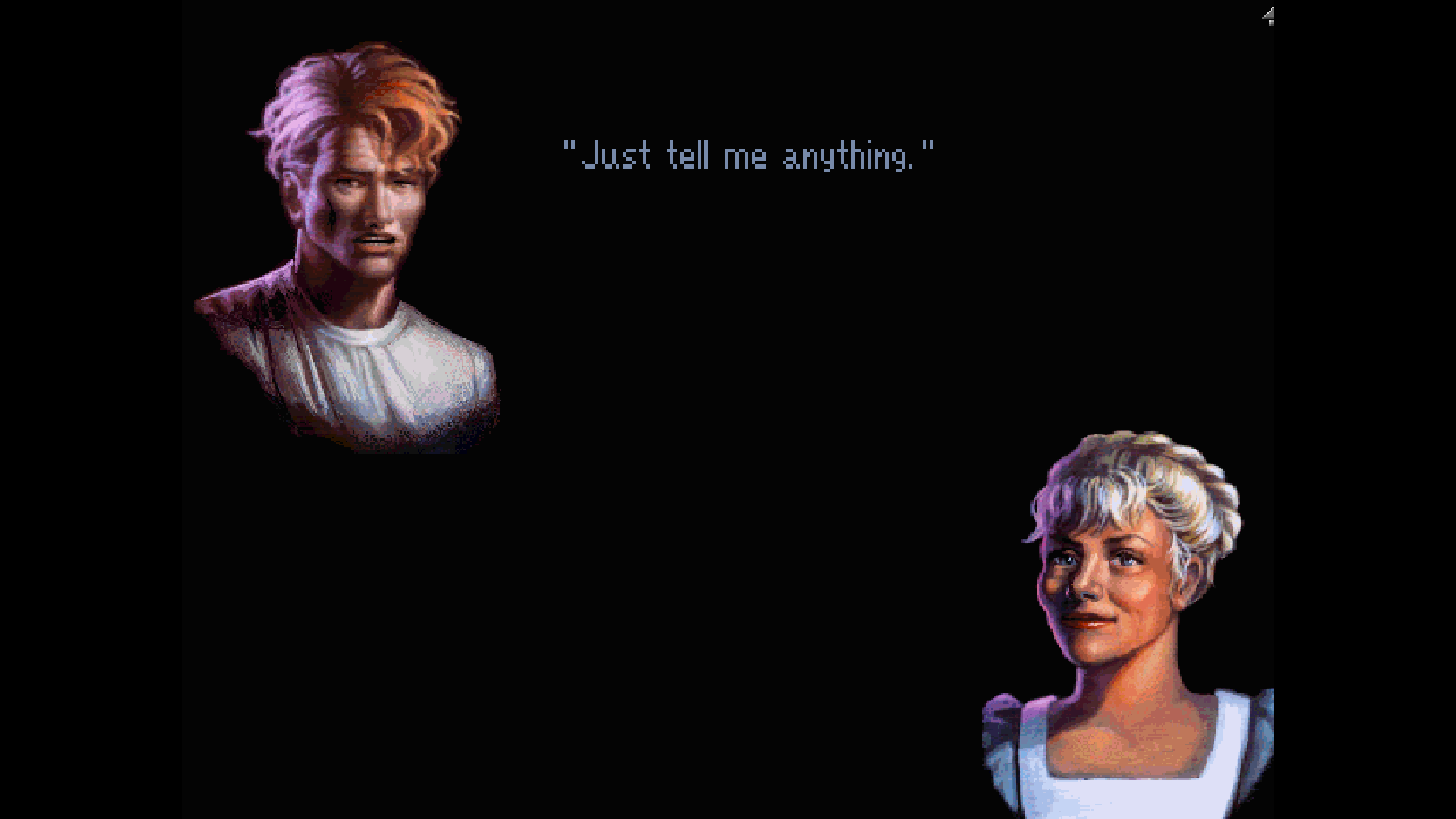Game Review: Gabriel Knight I: Sins of the Fathers
The Gabriel Knight games are one of the few game series where my sister can claim more knowledge than I can. She bought Gabriel Knight III when it came out, and while I never played it because of the III in its name--which seems odd in hindsight, because I had no problem starting King's Quest with King's Quest V, other than fifteen minutes played at a friend's house--but my sister played and beat the whole game. Without walkthroughs, if I remember right, though I know that she had uriany's assistance with some of the puzzles. I don't know how she beat the cat hair mustache puzzle, but she did.
And now, I follow in the trail she blazed a decade and a half ago, though starting with the first game instead of the third game. As you do, when all the games are available for cheaper than they've ever been and will run on basically any platform you have. Thank you, gog.com.
Note: this review will contain spoilers from here on out. You have been warned.

Based on how people react to him, this is not a spoiler.
The heroprotagonist of our story is the titular Gabriel Knight, aspiring author, struggling used book-store owner, secret descendant of a family of warriors descended from Longinus (he of the famed lance) and deputized by Jesus to fight against the creatures of the night on behalf of humanity, and general cad and sociopathic kleptomaniac. Only three of those are obvious at the beginning of the game, obviously. He lives in New Orleans, and thinking he can use a series of ritualistic murders committed around town as the seed of a new book, he reaches out to his friend Mosely, a detective in the NOPD. He quickly gets sucked in to trying to solve the murders, however, and discovers a secret conspiracy that reaches through the depths of history and into the halls of power in New Orleans, all the while taking everything that's not nailed down and being an asshole to people.

This is from a man who has lived in New Orleans all his life.
The story is mostly the work of Jane Jensen, and I can see why everyone praised Gabriel Knight for its story when it came out. It's true that it's drawing on the same template that works like Rosemary's Baby do, with a secretive witch cult who have unspecified-but-puissant occult mastery, tentacles all throughout the high and low echelons of society, the ability to flawlessly cover up crimes to the extent that everyone but the plucky protagonist dismisses all evidence to the contrary, and sinister goals, but switching the setting to New Orleans and making the hidden cult a group of voodoo practitioners rather than Satanist witches does a lot to prevent the game from being too much of a retread.
I know essentially nothing about voodoo of any variety, so it's possible that a practitioner or someone more knowledgeable might find a lot to criticize. It certainly plays heavily into the "oppressed people have magic powers" stereotype, and the idea of an evil voodoo cult itself plays into a lot of stereotypes. On the other hand, there's a distinction made between religious voodoo practices and the idea that voodoo is all dancing in the swamp and secret conspiracies and cabrit sans cor, and one section of the game takes place in West Africa. There's an article that goes a bit more into the good and bad points here, if you're interested. It's clear that Jensen did a lot of research, at least.

This is not the lowest that Gabriel sinks.
Unfortunately, I think that just brings the tropes of adventure gaming into even greater relief. I mentioned above that Gabriel is a sociopathic kleptomaniac not because it's part of his character, but because he's an adventure game protagonist. It took me a long time to move on from the early part of the game because I didn't want to ask some people about some topics because I thought that it would make Gabriel come off as an asshole or be really embarrassing. But this is adventure gaming. There's no room for nuance here. You will click every conversation topic until the NPCs repeat themselves, click every item on everyone, look at every hotspot, poke at every pixel, and you will like it. There's a quote in Bob Mackey's excellent Day of the Tentacle Oral History that speaks to this:Tim Schafer: You see in modern reviews of adventure games when they talk about how hard the puzzles are, I feel like those people did not poke on them enough. In the old days, you were expected to talk to everybody. Talk to them all, exhaust the dialogue trees, talk to everybody, try all the objects. If you're trying to open a door, and one of them will be like, “No, I can't use that, because it's rusted shut. If only I could break the rust,” or something. Get some hint, "Oh, I think I know what to do now."
In the classic adventure game tradition, there's a lot of pixel-hunting. There were a couple times that I wandered around for a while before finding the exact 2x3 block of pixels to click on or consulted a walkthrough only to realize that I hadn't asked the professor about voodoo hounfours even though I asked him about everything else and asked everyone else about everything, and when I knew what to do it's mostly asking embarrassing questions, badgering people about subjects they know nothing about, and stealing everything I can find.
And because of that, Gabriel came off as really unsympathetic. His assistant Grace should sue him for sexual harassment based on his constant flirting with her (and every other woman he meets, but unlike them Grace works for him), and his friend Mosely should break off all ties and probably have him arrested. In the course of the game, I ended up stealing Mosely's badge to impersonate an officer of the law, tampering with evidence, and stealing his credit cards and charging multiple international flights on them. I was going to add "breaking into his office," but he does give Gabriel the key, so that one is actually legitimate.

Fancy meeting you here.
I'm a big fan of pixel art and the comic book scenes in Gabriel Knight that are sometimes used for cutscenes looked excellent, but I found most of the art to be pretty middling overall because of its effects on gameplay. The biggest problem is that there was no pop for any interactive items. Some of them were set off by color choices, but there were a lot of items and hotspots that blended into the background and required--you guessed it--clicking everything on everything. Otherwise, good luck finding the white paper set among other white papers on a light-colored desk or the particular three-pixel-wide strip of glyphs Gabriel needs to read.
But that's not universally true. There were some odd moments with some items that seemed to be much higher resolution than other items around them, like the newspaper delivered every day to Gabriel's book shop. It was a bit like the way the character model changed in Heroine's Quest, except that Gabriel Knight is from 1993 and natively 640x480 so I don't know where it's coming from. Maybe it's the result of gog's tinkering to get the game to work? Sometimes these are interactive items, but sometimes they aren't, and sometimes there are interactive items it doesn't happen to, so there's no consistency and I can't use that as a judge either.
As an aside, while poking around I found this article about the use of color to enhance theme in Gabriel Knight and how the remake doesn't respect those choices and comes off the poorer for it.

LOOK WALL. OPEN WALL. TAKE WALL. OPERATE WALL. PUSH WALL.
The interface is kind of odd. There's no text parser, but apparently there were a lot of complaints to Sierra that the new icon-based interface for adventure games was dumbing the gameplay down to stupid baby level, so instead of move/look/talk/interact/item, there's a group of eight icons. Talk is expanded into one icon for banter and one icon for questioning, and interact is split into take, open, operate, and move. Mostly, this just serves to make using the interface more annoying. Take is probably 50% of the uses of interact, move only gets used a couple times, and the number of times you need open or operate when a single unified context-dependent interact would lead to confusion can probably be counted on a single hand, if that.

It begins.
All that said, I'm impressed at the gameplay structure. Early point-and-click adventure games were notorious for unwinnable situations. Anyone who played King's Quest V like I did probably remembers having to buy the pie in town and carry it around in your tunic so that halfway through the game you can throw it at a yeti's face so that it falls off a mountain (I am not making this up) or having to throw the shoe at the cat before it catches the rat so that later on when Graham is captured and thrown into prison, the grateful rat will let him out, and the concurrent rage when a missed action leads to an unwinnable situation.
Gabriel Knight avoids all of that by dividing itself up into ten days. Each day has tasks that Gabriel must accomplish before it "gets late," Gabriel goes back home and goes to bed, and the next day starts. It's impossible to continue on to the next day until you finish all the tasks that make up the current day, so there's no worry about progressing too much and missing some key item. The only thing you can miss are a few optional interactions that give you extra points and help provide color or information.
That said, while the puzzles all made sense, I had a lot of trouble at times figuring out what I was supposed to be doing. Realizing that the poem fragments at the beginning of each day were supposed to provide a clue as to the actions Gabriel is supposed to do on that day helped a bit, but there were definitely puzzles like the clock where the parts you have to put together are really widely scattered. Not as widely scattered as USE PIE ON YETI, though, so at least there's that.

Damn, Gabriel, don't be so thirsty.
I beat the game with 338 out of 342 points, which is just close enough to make finding out where I missed the last few points far too annoying to actually try to do. Maybe if there was a chapter breakdown so I knew where I had to look, but Gabriel Knight is from a time before such conveniences. It's kind of amazing that it's impossible to get stuck and have to restart the whole game.
I can see where all the praise for Gabriel Knight's story comes from. When you strip away the silly adventure game contrivances, it's a pretty good mystery story, which is why it ended up getting turned into a book. Huh, 4.5 stars is pretty amazing for a video game-based novel. Maybe that speaks to how the gamey elements detracted from exploring the plot. It's certainly a better plot than my favorite Sierra games, the Quest for Glory series, even if the QFG series's mix of RPG and adventure leads to much better gameplay. Unfortunately, it also suffered from chasing the dragon of technological advancement that was so prevelant in the 90s--Gabriel Knight II is an FMV game with all that entails, and Gabriel Knight III is a 3D adventure game. At least it's still point and click and doesn't have tank controls like Grim Fandango did before the remaster. This one is still a classic point-and-click, though, and more than worth the half-dozen or so hours it took to finish it.
And now, I follow in the trail she blazed a decade and a half ago, though starting with the first game instead of the third game. As you do, when all the games are available for cheaper than they've ever been and will run on basically any platform you have. Thank you, gog.com.
Note: this review will contain spoilers from here on out. You have been warned.

Based on how people react to him, this is not a spoiler.
The heroprotagonist of our story is the titular Gabriel Knight, aspiring author, struggling used book-store owner, secret descendant of a family of warriors descended from Longinus (he of the famed lance) and deputized by Jesus to fight against the creatures of the night on behalf of humanity, and general cad and sociopathic kleptomaniac. Only three of those are obvious at the beginning of the game, obviously. He lives in New Orleans, and thinking he can use a series of ritualistic murders committed around town as the seed of a new book, he reaches out to his friend Mosely, a detective in the NOPD. He quickly gets sucked in to trying to solve the murders, however, and discovers a secret conspiracy that reaches through the depths of history and into the halls of power in New Orleans, all the while taking everything that's not nailed down and being an asshole to people.

This is from a man who has lived in New Orleans all his life.
The story is mostly the work of Jane Jensen, and I can see why everyone praised Gabriel Knight for its story when it came out. It's true that it's drawing on the same template that works like Rosemary's Baby do, with a secretive witch cult who have unspecified-but-puissant occult mastery, tentacles all throughout the high and low echelons of society, the ability to flawlessly cover up crimes to the extent that everyone but the plucky protagonist dismisses all evidence to the contrary, and sinister goals, but switching the setting to New Orleans and making the hidden cult a group of voodoo practitioners rather than Satanist witches does a lot to prevent the game from being too much of a retread.
I know essentially nothing about voodoo of any variety, so it's possible that a practitioner or someone more knowledgeable might find a lot to criticize. It certainly plays heavily into the "oppressed people have magic powers" stereotype, and the idea of an evil voodoo cult itself plays into a lot of stereotypes. On the other hand, there's a distinction made between religious voodoo practices and the idea that voodoo is all dancing in the swamp and secret conspiracies and cabrit sans cor, and one section of the game takes place in West Africa. There's an article that goes a bit more into the good and bad points here, if you're interested. It's clear that Jensen did a lot of research, at least.

This is not the lowest that Gabriel sinks.
Unfortunately, I think that just brings the tropes of adventure gaming into even greater relief. I mentioned above that Gabriel is a sociopathic kleptomaniac not because it's part of his character, but because he's an adventure game protagonist. It took me a long time to move on from the early part of the game because I didn't want to ask some people about some topics because I thought that it would make Gabriel come off as an asshole or be really embarrassing. But this is adventure gaming. There's no room for nuance here. You will click every conversation topic until the NPCs repeat themselves, click every item on everyone, look at every hotspot, poke at every pixel, and you will like it. There's a quote in Bob Mackey's excellent Day of the Tentacle Oral History that speaks to this:Tim Schafer: You see in modern reviews of adventure games when they talk about how hard the puzzles are, I feel like those people did not poke on them enough. In the old days, you were expected to talk to everybody. Talk to them all, exhaust the dialogue trees, talk to everybody, try all the objects. If you're trying to open a door, and one of them will be like, “No, I can't use that, because it's rusted shut. If only I could break the rust,” or something. Get some hint, "Oh, I think I know what to do now."
In the classic adventure game tradition, there's a lot of pixel-hunting. There were a couple times that I wandered around for a while before finding the exact 2x3 block of pixels to click on or consulted a walkthrough only to realize that I hadn't asked the professor about voodoo hounfours even though I asked him about everything else and asked everyone else about everything, and when I knew what to do it's mostly asking embarrassing questions, badgering people about subjects they know nothing about, and stealing everything I can find.
And because of that, Gabriel came off as really unsympathetic. His assistant Grace should sue him for sexual harassment based on his constant flirting with her (and every other woman he meets, but unlike them Grace works for him), and his friend Mosely should break off all ties and probably have him arrested. In the course of the game, I ended up stealing Mosely's badge to impersonate an officer of the law, tampering with evidence, and stealing his credit cards and charging multiple international flights on them. I was going to add "breaking into his office," but he does give Gabriel the key, so that one is actually legitimate.

Fancy meeting you here.
I'm a big fan of pixel art and the comic book scenes in Gabriel Knight that are sometimes used for cutscenes looked excellent, but I found most of the art to be pretty middling overall because of its effects on gameplay. The biggest problem is that there was no pop for any interactive items. Some of them were set off by color choices, but there were a lot of items and hotspots that blended into the background and required--you guessed it--clicking everything on everything. Otherwise, good luck finding the white paper set among other white papers on a light-colored desk or the particular three-pixel-wide strip of glyphs Gabriel needs to read.
But that's not universally true. There were some odd moments with some items that seemed to be much higher resolution than other items around them, like the newspaper delivered every day to Gabriel's book shop. It was a bit like the way the character model changed in Heroine's Quest, except that Gabriel Knight is from 1993 and natively 640x480 so I don't know where it's coming from. Maybe it's the result of gog's tinkering to get the game to work? Sometimes these are interactive items, but sometimes they aren't, and sometimes there are interactive items it doesn't happen to, so there's no consistency and I can't use that as a judge either.
As an aside, while poking around I found this article about the use of color to enhance theme in Gabriel Knight and how the remake doesn't respect those choices and comes off the poorer for it.

LOOK WALL. OPEN WALL. TAKE WALL. OPERATE WALL. PUSH WALL.
The interface is kind of odd. There's no text parser, but apparently there were a lot of complaints to Sierra that the new icon-based interface for adventure games was dumbing the gameplay down to stupid baby level, so instead of move/look/talk/interact/item, there's a group of eight icons. Talk is expanded into one icon for banter and one icon for questioning, and interact is split into take, open, operate, and move. Mostly, this just serves to make using the interface more annoying. Take is probably 50% of the uses of interact, move only gets used a couple times, and the number of times you need open or operate when a single unified context-dependent interact would lead to confusion can probably be counted on a single hand, if that.

It begins.
All that said, I'm impressed at the gameplay structure. Early point-and-click adventure games were notorious for unwinnable situations. Anyone who played King's Quest V like I did probably remembers having to buy the pie in town and carry it around in your tunic so that halfway through the game you can throw it at a yeti's face so that it falls off a mountain (I am not making this up) or having to throw the shoe at the cat before it catches the rat so that later on when Graham is captured and thrown into prison, the grateful rat will let him out, and the concurrent rage when a missed action leads to an unwinnable situation.
Gabriel Knight avoids all of that by dividing itself up into ten days. Each day has tasks that Gabriel must accomplish before it "gets late," Gabriel goes back home and goes to bed, and the next day starts. It's impossible to continue on to the next day until you finish all the tasks that make up the current day, so there's no worry about progressing too much and missing some key item. The only thing you can miss are a few optional interactions that give you extra points and help provide color or information.
That said, while the puzzles all made sense, I had a lot of trouble at times figuring out what I was supposed to be doing. Realizing that the poem fragments at the beginning of each day were supposed to provide a clue as to the actions Gabriel is supposed to do on that day helped a bit, but there were definitely puzzles like the clock where the parts you have to put together are really widely scattered. Not as widely scattered as USE PIE ON YETI, though, so at least there's that.

Damn, Gabriel, don't be so thirsty.
I beat the game with 338 out of 342 points, which is just close enough to make finding out where I missed the last few points far too annoying to actually try to do. Maybe if there was a chapter breakdown so I knew where I had to look, but Gabriel Knight is from a time before such conveniences. It's kind of amazing that it's impossible to get stuck and have to restart the whole game.
I can see where all the praise for Gabriel Knight's story comes from. When you strip away the silly adventure game contrivances, it's a pretty good mystery story, which is why it ended up getting turned into a book. Huh, 4.5 stars is pretty amazing for a video game-based novel. Maybe that speaks to how the gamey elements detracted from exploring the plot. It's certainly a better plot than my favorite Sierra games, the Quest for Glory series, even if the QFG series's mix of RPG and adventure leads to much better gameplay. Unfortunately, it also suffered from chasing the dragon of technological advancement that was so prevelant in the 90s--Gabriel Knight II is an FMV game with all that entails, and Gabriel Knight III is a 3D adventure game. At least it's still point and click and doesn't have tank controls like Grim Fandango did before the remaster. This one is still a classic point-and-click, though, and more than worth the half-dozen or so hours it took to finish it.